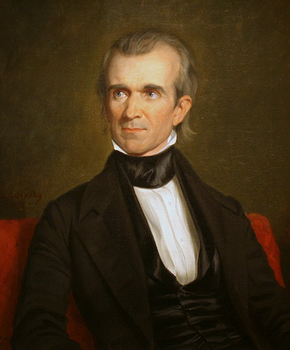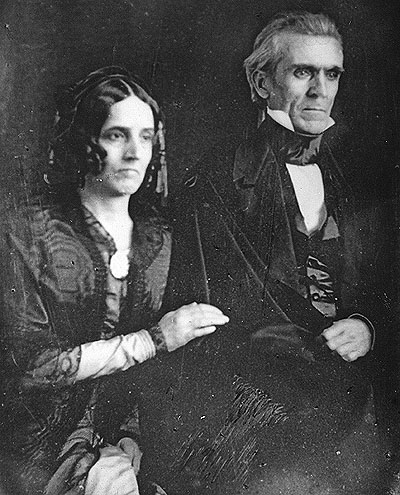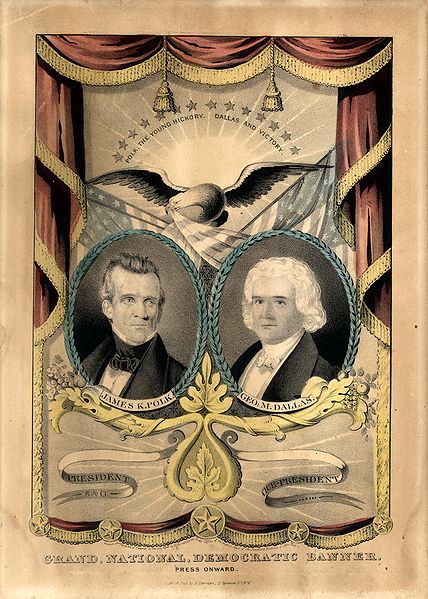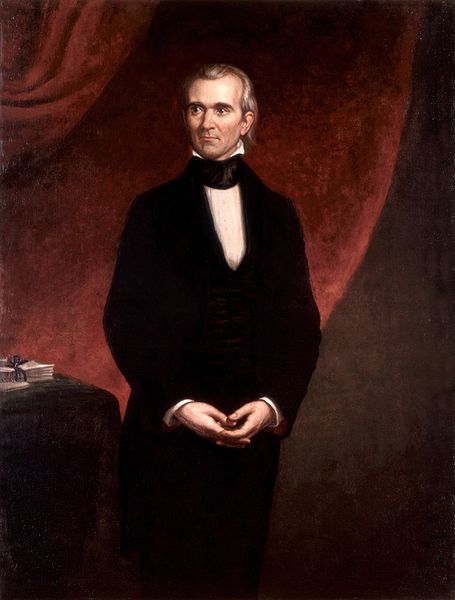| James Knox Polk | |
|---|---|
 |
|
| 11th United States President « Previous Next » |
|
| In office | Mar. 4, 1845 – Mar. 4, 1849 |
| V. President | George Dallas |
| Political Party | Democratic Party |
| Personal Info | |
| Born | Nov. 2, 1795 |
| Died | June 15, 1849 (at age 53) |
| Religion | Presbyterianism |
| School | University of North Carolina, Chapel Hill |
| Profession | Lawyer, Planter |
| Signature | |
| Wife | Sarah Childress |
| U.S. Presidents 1-15 | |
| 1. George Washington (1789–1797) | |
| 2. John Adams (1797-1801) | |
| 3. Thomas Jefferson (1801-1809) | |
| 4. James Madison (1809-1817) | |
| 5. James Monroe (1817-1825) | |
| 6. John Quincy Adams (1825-1829) | |
| 7. Andrew Jackson (1829-1837) | |
| 8. Martin Van Buren (1837-1841) | |
| 9. William Henry Harrison (1841-1841) | |
| 10. John Tyler (1841-1845) | |
| 11. James Knox Polk (1845-1849) | |
| 12. Zachary Taylor (1849-1850) | |
| 13. Millard Fillmore (1850-1853) | |
| 14. Franklin Pierce (1853-1857) | |
| 15. James Buchanan (1857-1861) | |
| List of All the Presidents |
James Knox Polk, the eleventh U.S. President, and one of the most highly acclaimed U.S. Presidents, was born in Mecklenburg, North Carolina to a family of ten. Samuel, his father, was a farmer and slaveholder. His mother, Jane, descended from a brother of religious reformer, John Knox. James was named after his grandfather and like most of the early settlers who are of Scots-Irish descent in North Carolina, the Knoxes and Polks were Presbyterian.
His mother was a devotee of the Presbyterian beliefs, while his father rejected the dogmatic nature of the faith. Young James was home schooled because he had health problems as a child. He had to undergo surgery for gallstones and their trips to the west had apparently taken much of the strength he had in his younger years.
Education & Career
His father wanted to give him a job in the mercantile business after his recovery, but he refused. He enrolled at Zion Church and eventually attended school in Murfreesboro. He spent his college years at the UNC where he participated in the Dialectic Society and learned a great deal about oratory. He graduated in May 1818 with honors.
After he graduated, he went back to Nashville to take further studies in law under Felix Grundy, a renowned trial lawyer who became his first mentor. In 1819, James became clerk to the Tennessee State Senate and was re-elected in 1821 to serve until the following year. He was officially recognized by the bar in 1820 and had a flourishing career in law due to the abundance of debt cases from the Panic of 1819.
 Polk joined the militia in 1822, became a Captain and was promoted to Colonel. He was recognized highly for his mastery of oration, thus earning him a popular nickname, “Napoleon of the Stump”. He eventually resigned as a clerk and ran for the state legislature in Tennessee in 1823. He won over William Yancey, the incumbent representative of Maury County. He was also an avid supporter of Andrew Jackson, whom he became friends with. When Jackson eventually won the presidency in the 1828 election, Polk was appointed House Speaker, where he served for four years. His support for Jackson earned him another nickname, “Young Hickory”. He was elected Tennessee governor in 1839. He attempted another term and in 1841, he ran a re-election campaign. During that time, the country suffered from severe depression, farm foreclosures and massive bank failures that led the new Whig party to blame Jackson’s presidency. Polk lost the race and after another defeat in 1843, he decided to go back to his family plantation.
Polk joined the militia in 1822, became a Captain and was promoted to Colonel. He was recognized highly for his mastery of oration, thus earning him a popular nickname, “Napoleon of the Stump”. He eventually resigned as a clerk and ran for the state legislature in Tennessee in 1823. He won over William Yancey, the incumbent representative of Maury County. He was also an avid supporter of Andrew Jackson, whom he became friends with. When Jackson eventually won the presidency in the 1828 election, Polk was appointed House Speaker, where he served for four years. His support for Jackson earned him another nickname, “Young Hickory”. He was elected Tennessee governor in 1839. He attempted another term and in 1841, he ran a re-election campaign. During that time, the country suffered from severe depression, farm foreclosures and massive bank failures that led the new Whig party to blame Jackson’s presidency. Polk lost the race and after another defeat in 1843, he decided to go back to his family plantation.
Polk’s Marriage
Polk was married to Sarah Childress who was of great help in his political career. She was dubbed to be the perfect wife for a politician – well educated, wealthy, entertaining, and with good public relations. Her husband proved to be more reserved, yet after his second defeat in the gubernatorial race, they decided to settle in on their plantation, not knowing they would be moving to the White House in the next years.
1844 Presidential Campaign and Presidency
 The Democrats were then convening to select a presidential nominee for the 1844 election, and surprisingly, Polk’s name was an unexpected top pick. Martin van Buren was then the front runner, but since he lost to W.H. Harrison in 1840, many concluded that he was a weak choice. He also lost the support of the Southerners when he opposed the annexation of Texas. As a result, they ended up with the first dark horse candidate, James K. Polk. Whigs started to ask who he was, and Polk answered them with his explicit platforms.
The Democrats were then convening to select a presidential nominee for the 1844 election, and surprisingly, Polk’s name was an unexpected top pick. Martin van Buren was then the front runner, but since he lost to W.H. Harrison in 1840, many concluded that he was a weak choice. He also lost the support of the Southerners when he opposed the annexation of Texas. As a result, they ended up with the first dark horse candidate, James K. Polk. Whigs started to ask who he was, and Polk answered them with his explicit platforms.
Polk supported Texas’ annexation and the “reoccupation” of Oregon, which was then occupied by both British and Americans. He came up with the balanced idea of having a slave state (Texas) and a free state (Oregon). The presidential election proved to be vicious. Slander and slavery were thrown at the center of things. Polk won the race with a very thin margin of 39,000 votes. He was sworn in on March 1845 and at 49, became the youngest president that time.
His administration had very clear and defined goals – the reestablishment of the independent treasury, tariff reduction and the acquisition of Oregon, California, and New Mexico. He pledged to finish only one presidential term and accomplished all these goals in a span of four years. During his term, though, he met many harsh criticisms for allegedly spreading slavery through Texas’ annexation and the war with Mexico.
 However, he was a strong proponent of expansion. He wanted to achieve balance between the North and the South in terms of their respective interests, which was why he pushed for Oregon’s acquisition. He also sought to gain California from Mexico. He was interested in expanding territories, and not starting war. He placed enormous pressure on Britain in order to achieve a resolve on the boundary dispute involving Oregon. The Oregon Treaty was signed in 1846 in compliance with America’s proposal.
However, he was a strong proponent of expansion. He wanted to achieve balance between the North and the South in terms of their respective interests, which was why he pushed for Oregon’s acquisition. He also sought to gain California from Mexico. He was interested in expanding territories, and not starting war. He placed enormous pressure on Britain in order to achieve a resolve on the boundary dispute involving Oregon. The Oregon Treaty was signed in 1846 in compliance with America’s proposal.
Polk also turned his eyes to California and wanted to acquire it from Mexico before the Europeans did. His primary point of interest was the San Francisco bay area, a potentially lucrative trade port with the Asian regions. Diplomat John Slidell was sent to purchase the territory from Mexico but his arrival caused turmoil in the country when it was discovered that he was sent to buy out California and not offer any compensation for losses in the Texas annexation.
He was refused entry to Mexico, which cited problems with his credentials. Polk wanted a negotiation and he sent a troop headed by General Taylor to occupy the areas between Rio Grande and Nueces River. Eventually, both countries claimed California. Congress then declared war and supported all military operations. After several victories by the American forces, they were able to occupy Mexico City. In 1848, New Mexico and California were ceded in return for fifteen million dollars. Just as Polk added vast territories to the country, his acquisitions spawned quarrels between Northerners and Southerners due to the widespread slavery.
 Among Polk’s last Presidential activity included the passing of the bill that created the Department of Interior, which was the very first new cabinet post that was created since the Republic’s early days. His stint in the White House proved to be a big factor that damaged his health. He exited the office in March 1849 after many exhausting years of being a public servant. He was said to have lost weight, and to have suffered from cholera during a goodwill tour. Polk had to cut his trip short due to fatigue and severe diarrhea. He died in Nashville, Tennessee in June of the same year.
Among Polk’s last Presidential activity included the passing of the bill that created the Department of Interior, which was the very first new cabinet post that was created since the Republic’s early days. His stint in the White House proved to be a big factor that damaged his health. He exited the office in March 1849 after many exhausting years of being a public servant. He was said to have lost weight, and to have suffered from cholera during a goodwill tour. Polk had to cut his trip short due to fatigue and severe diarrhea. He died in Nashville, Tennessee in June of the same year.
Today, James K. Polk is recognized as the president who turned the country into a very big nation. The United States’ landmass was a third bigger after his office. The impact of his many territorial acquisitions was greatly significant to the current map of the U.S.. He entered electoral politics with a focused mind and a clear agenda together with his strong set of convictions. He is now said to be the strongest president right between Lincoln and Jackson.